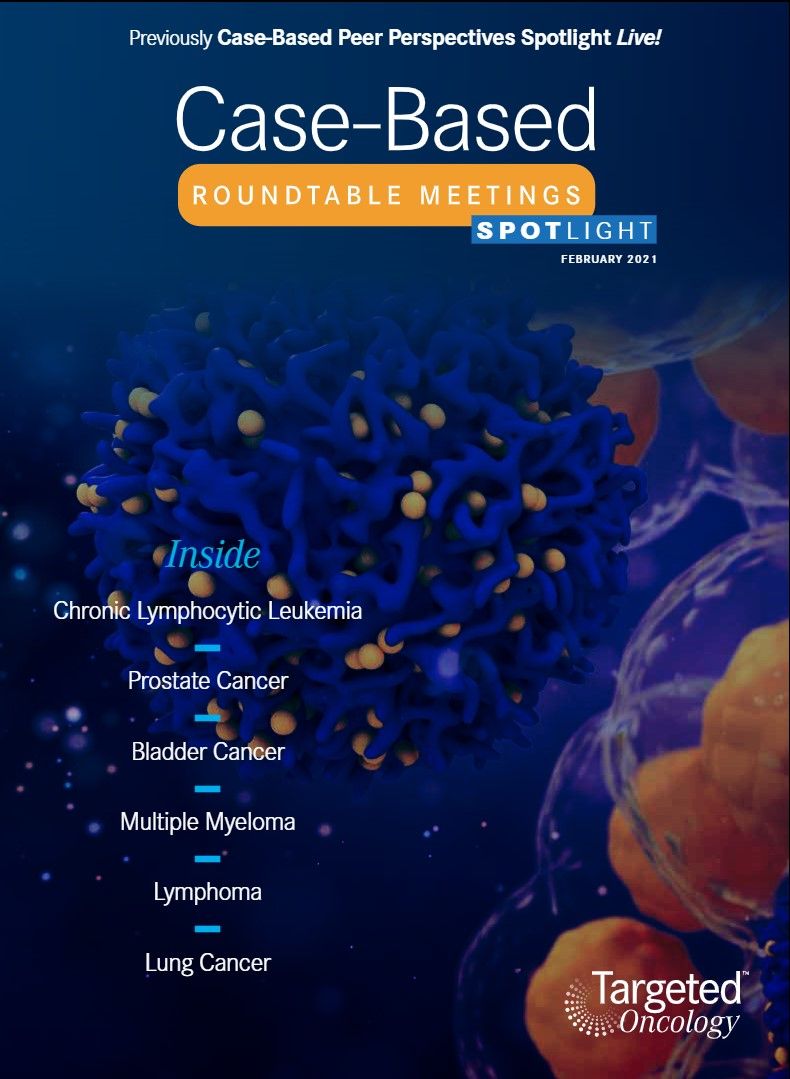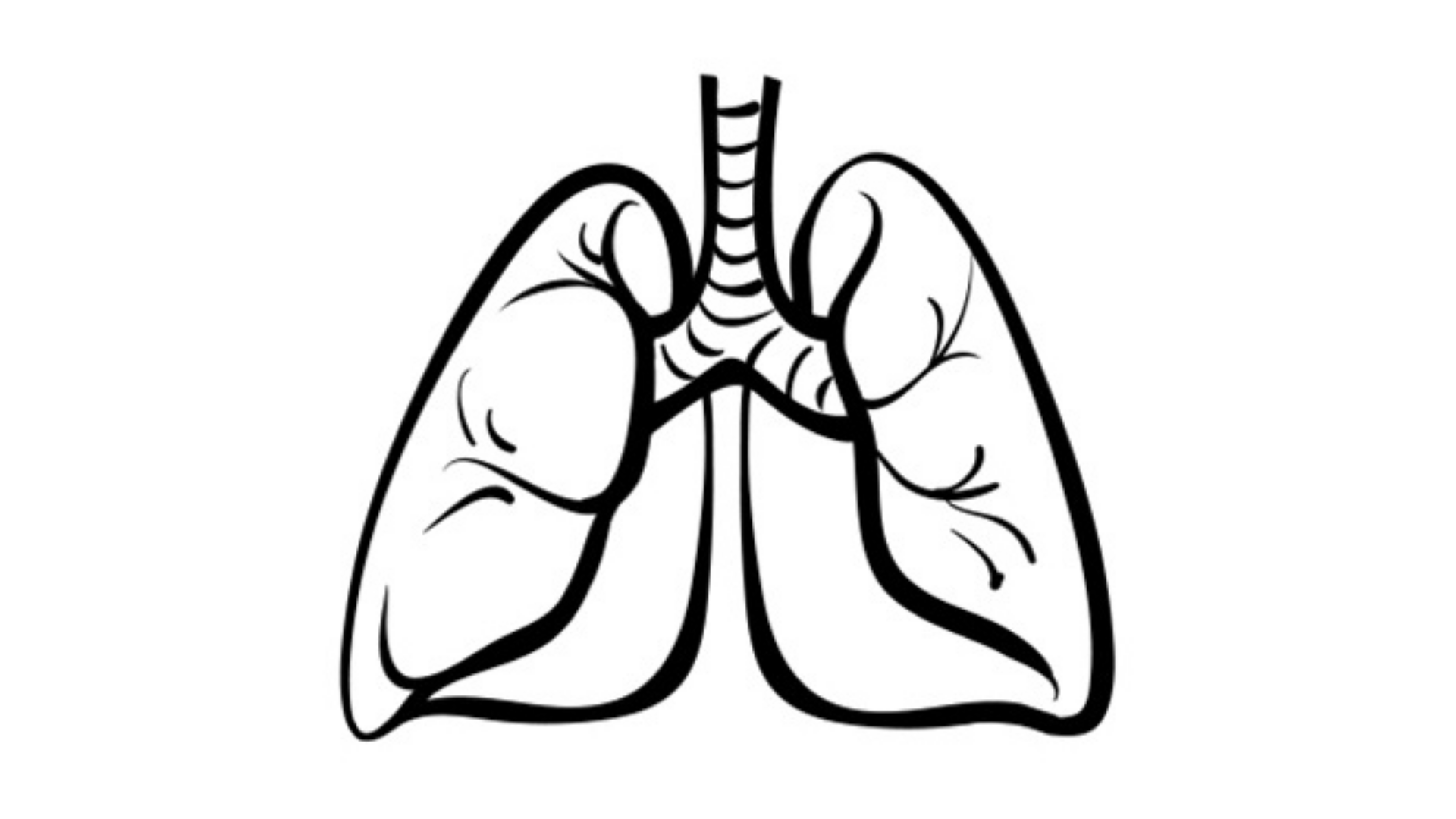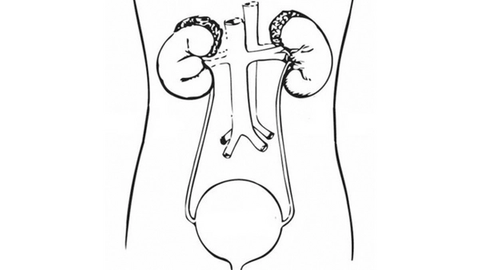Bupathi Explores Second-line Therapies for a Patient With Transitional Cell Carcinoma
During a virtual Targeted Oncology Case-Based Roundtable, Manojkumar Bupathi, MD, MS, reviewed second-line treatment options for transitional cell carcinoma.
Manojkumar Bupathi, MD, MS

During a virtual Targeted Oncology Case-Based Roundtable, Manojkumar Bupathi, MD, MS, a medical oncologist and hematologist at the Rocky Mountain Cancer Centers in Aurora, CO, reviewed second-line treatment options for transitional cell carcinoma.

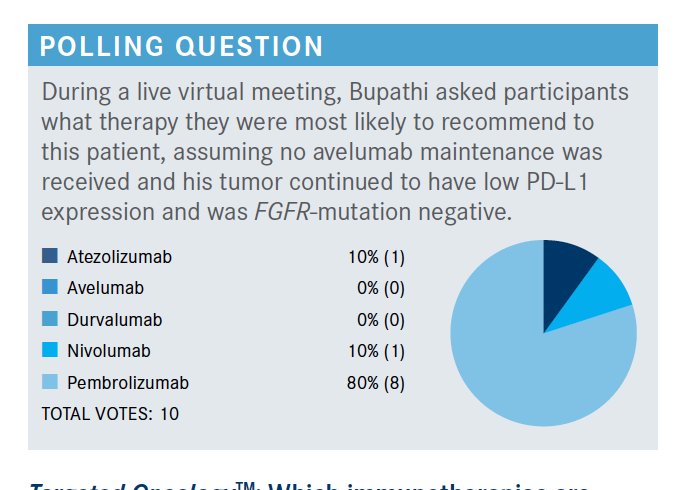
Targeted OncologyTM: Which immunotherapies are available in the setting of urothelial cancer, and how do they compare?
BUPATHI: There are 5 immunotherapies that are currently used and can be used in patients with advanced bladder cancer. There are atezolizumab [Tecentriq], nivolumab [Opdivo], durvalumab [Imfinzi], avelumab [Bavencio], and pembrolizumab [Keytruda]. Atezolizumab and pembrolizumab were in phase 3 studies, and the others were either in single-arm phase 2 or phase 1/2 studies.
The overall response rate for pembrolizumab was 21.1%1 versus nivolumab with 20.7%2 and atezolizumab at 13.4%.3 For the duration of response, the durvalumab was at 77% at 5.8 months4 and then pembrolizumab at 72% at 14.1 months,1 and the nivolumab at 59% greater than 12 months at 33.7 months’ follow-up.5 When you look at the median progression-free survival [PFS], it was almost all similar to each other. The atezolizumab, nivolumab, and pembrolizumab were 1.9 to 2.1 months’ median PFS. The toxicity profile was [also] about the same in all of them.
I tend to use pembrolizumab because it has the [most] data; it’s been around the longest.
What are some details of these data?
The phase 3 KEYNOTE-045 trial [NCT02256436] looked at pembrolizumab as second-line therapy for patients with advanced urothelial cancer.1 Looking at overall survival [OS], there was a hazard ratio of 0.73 [95% CI, 0.59-0.91], and then for patients with a PD-L1 combined positive score [CPS] greater than 10%, the hazard ratio was better at 0.57 [95% CI, 0.37 -0.88]. Patients with PD-L1 CPS with a 1% cutoff still had a benefit with pembrolizumab versus chemotherapy, regardless whether the PD-L1 expression was less than 1% or greater than or equal to 1% versus the same at less than, equal to, or greater than 10%. So pembrolizumab can be used whether patients express as PD-L1 positive or negative. If they are positive, the response seems to be a bit better.
Atezolizumab as second-line immune checkpoint inhibitor therapy for metastatic urothelial cancer [had] overlapping OS data.3 The median OS was 8.6 months for atezolizumab versus 8.0 for chemotherapy. The hazard ratio was 0.85 [95% CI, 0.73-0.99]. It did not significantly differ between the 2 study arms. When you look the median OS [in the IC2/3 population], it was 11.1 versus 10.6 months. The Kaplan-Meier curves, at least early on, intertwined, and they didn’t separate out until much further out.
Nivolumab in the second-line setting…had 3 different curves that looked at patients expressing PD-L1 less than 1%, greater than or equal to 1%, and all patients who were tumor mutational burden evaluable.2 When you look at all the treated patients, the median OS was 8.6 months [95% CI, 6.1-11.3 months], the PD-L1 less than 1% population OS was 6.0 [95% CI, 4.4-8.1 months], the PD-L1 positive population OS was 11.9 months [95% CI, 9.1-19.1 months], and OS in all patients with tumor mutation burden was 7.2 months [95% CI, 5.5-11.4 months]. Regardless of whether a patient had a PD-L1 positive or negative tumor, they tend to respond, but those who had positive tumors tended to have a better response.
Durvalumab was similar, looking at PD-L1 high, low, as well as total or low negative. They looked at the 6 months, 9 months, and 12 months in terms of percentage of survival, and there is still a benefit across all 3, or both groups, but the benefit tends to be a little bit better with PD-L1 high compared with those that are lower or negative.
What’s interesting is that, in the second-line setting of avelumab, when you look at the median OS for [JAVELIN Solid Tumor (NCT01772004)], it was 6.5 months [95% CI, 4.8-9.5 months].6 With JAVELIN Bladder 100 [NCT02603432], they improved survival by 7 months [21.4 months with avelumab maintenance vs 14.3 months with no maintenance].7 So, you essentially are getting the same benefit, whether you’re using it as second line or as maintenance in the first line. The PD-L1 positive [population OS in JAVELIN Solid Tumor] was 8.2 months [95% CI, 5.7-13.7], and the negative [population OS] was 6.2 [95% CI, 4.3-14.0]. So you still have a benefit with avelumab whether the patient’s tumor is PD-L1 positive or negative, in general.
With the way the PD-L1 status was checked with all 5 drugs, every single one of them was being looked at differently in terms of the assay being used. Every one of them had a different way to look at it.

How do the National Comprehensive Cancer Network (NCCN) guidelines suggest treating this patient population?
In the NCCN guidelines, the preferred regimen is pembrolizumab as a category 1 recommendation.8 You can use any of the other immunotherapy checkpoint inhibitors, as well as erdafitinib [Balversa], as second-line therapy.
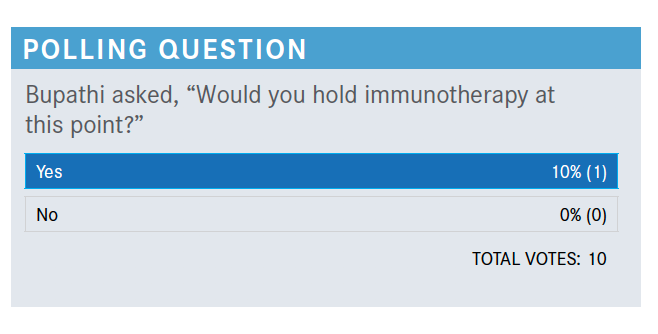
What is your approach toward management of pneumonitis related to checkpoint inhibitor therapy for patients?
Use steroids and infliximab [Remicade], and then hold [the drug].
The NCCN guidelines [for] how to manage pneumonitis are…[for] mild grade 1, consider holding or reassessing, and consider a chest CT scan.9 If it’s moderate, then hold immunotherapy [and use] steroids. If it’s severe, then permanently discontinue [the drug], and then maybe use infliximab or other agents.
What third-line options would you consider if this patient’s disease progresses? Have you used enfortumab vedotin-ejfv (EV; Padcev)?
I have not used it as a second-line treatment thus far. I’ve used it as front-line in combination with pembrolizumab. So, EV/pembrolizumab I have used, and I’ve seen great responses. We’ve had a number of patients on the trial with EV/pembrolizumab and had complete responses in almost half our patients. We’ve had phenomenal responses with the combination up front. EV will be moving up, and so I suspect that we’re going to be seeing good responses to EV as a secondline therapy, as well.
In the third-line setting, I have used it and have seen great responses, as well. I think my patient on EV the longest has been almost a year plus on third-line treatment.
Please describe some of the clinical trial data behind EV.
EV-201 [NCT03219333], which was a single-arm, pivotal phase 2 trial of EV, had a cohort for patients who received a prior PD-1/PD-L1 inhibitor and platinum-based therapy.10 The enrollment completed in July 2018. EV is a Nectin-4 inhibitor. It’s given once a week for 3 weeks on, 1 week off. The primary objective was ORR.
When you look at the EV-201, the ORR was 44%, duration of response was 7.6 months, and the OS was 12.4 [95% CI, 9.46-15.57]. It led to the accelerated approval of EV.
What are some other therapies relevant in urothelial cancer?
Another drug that’s up-and-coming in bladder cancer is sacituzumab govitecan-hziy [Trodelvy], which is a Trop-2 inhibitor. The payload for this is SN-38: It’s similar to the compound irinotecan but more potent.
The TROPHY-U-01 study [NCT03547973] had a cohort for patients who had received prior platinum therapy and checkpoint inhibitor.11 They received sacituzumab govitecan at 10 mg/kg on days 1 and 8, every 21 days. The primary objective was ORR. Patients with primary visceral metastases were included, with liver metastases at 28%, and they had a median of 3 prior treatments.
The ORR [was 27% (95% CI, 19%-37%)]. Median duration of response was 5.9 months [95% CI, 4.7-8.6]. There was a complete response rate of about 5%, or in 6 patients, and a partial response in 25 patients. The median OS was 10.5 months [95% CI, 8.2-12.3] in the third-line setting, which is quite impressive for this group of patients.
This drug is similar to irinotecan, so the biggest AEs that we see are diarrhea, neutropenia, alopecia, and fatigue. Growth factor support is certainly needed for these patients
REFERENCES:
1. Bellmunt J, de Wit R, Vaughn DJ, et al. Pembrolizumab as second-line therapy for advanced urothelial carcinoma. N Engl J Med. 2017;376(11):1015-1026. doi:10.1056/NEJMoa1613683
2. Galsky MD, Saci A, Szabo PM, et al. Nivolumab in patients with advanced platinum-resistant urothelial carcinoma: efficacy, safety, and biomarker analyses with extended follow-up from CheckMate 275. Clin Cancer Res. 2020;26(19):5120-5128. doi:10.1158/1078-0432.CCR-19-4162
3. Powles T, Dur.n I, van der Heijden MS, et al. Atezolizumab versus chemotherapy in patients with platinum-treated locally advanced or metastatic urothelial carcinoma (IMvigor211): a multicentre, open-label, phase 3 randomised controlled trial. Lancet. 2018;391(10122):748-757. doi:10.1016/S0140-6736(17)33297-X
4. Powles T, O’Donnell PH, Massard C, et al. Efficacy and safety of durvalumab in locally advanced or metastatic urothelial carcinoma: updated results from a phase 1/2 openlabel study. JAMA Oncol. 2017;3(9):e172411. doi:10.1001/jamaoncol.2017.2411
5. Siefker AO, Baron AD, Necchi A, et al. Nivolumab monotherapy in patients with advanced platinum-resistant urothelial carcinoma: efficacy and safety update from CheckMate 275. J Clin Oncol. 2019;37(suppl 15):4524. doi:10.1200/JCO.2019.37.15_suppl.4524
6. Patel MR, Ellerton J, Infante JR, et al. Avelumab in metastatic urothelial carcinoma after platinum failure (JAVELIN Solid Tumor): pooled results from two expansion cohorts of an open-label, phase 1 trial. Lancet Oncol. 2018;19(1):51-64. doi:10.1016/S1470-2045(17)30900-2
7. Powles T, Park SH, Voog E, et al. Avelumab maintenance therapy for advanced or metastatic urothelial carcinoma. N Engl J Med. 2020;383(13):1218-1230. doi:10.1056/NEJMoa2002788
8. NCCN. Clinical Practice Guidelines in Oncology. Bladder cancer, version 6.2020. Accessed February 3, 2021. https://bit.ly/3lold5s
9. NCCN. Clinical Practice Guidelines in Oncology. Management of immunotherapyrelated toxicities, version 1.2021. Accessed February 3, 2021. https://bit.ly/3arJIdw
10. O’Donnell P, Galsky MD, Rosenberg JE, et al. EV-201: Long-term results of enfortumab vedotin monotherapy for locally advanced or metastatic urothelial cancer previously treated with platinum and PD-1/PD-L1 inhibitors. Ann Oncol. 2020;31 (suppl 4):S550. doi:10.1016/annonc/annonc274
11. Loriot Y, Balar AV, Petrylak DP, et al. TROPHY-U-01 cohort 1 final results: a phase II study of sacituzumab govitecan (SG) in metastatic urothelial cancer (mUC) that has progressed after platinum (PLT) and checkpoint inhibitors (CPI). Ann Oncol. 2020;31(suppl 4):S1142-S1215. doi:10.1016/annonc/annonc325
